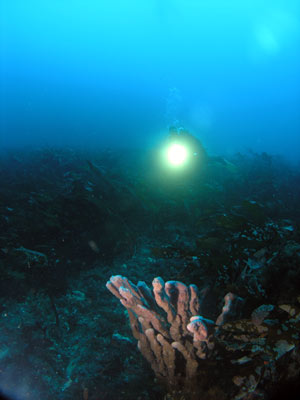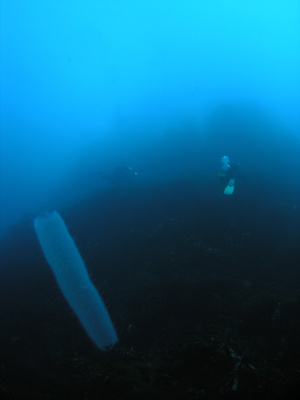|
The section of coastline from Eaglehawk Neck south to Tasman Island in south-eastern Tasmanian would have to be one of the most rugged and beautiful sections of coastline anywhere in the world. The cliffs are well over 200 metres high in spots and the constant pounding of the seas from the Southern Ocean have created spectacular caves, arches and islands that are simply breath-taking.
The same features above the water extend below the surface of the ocean, with caves and steep drop-offs all over the place.
About 10 kilometres south of the boat ramp at Pirates Bay there is a small rock island that sits about 200 metres off the coast at Thumbs Point. The island is at the northern side of the entrance to Fortescue Bay. The island extends in an east-west direction and is probably 200 metres long and perhaps 50 metres wide. It has three small peaks and is named The Thumbs. All around this island the water drops off to well over 40 metres in an extremely steep sloping wall. The island provides some protection from the prevailing south-easterly swell and the depth means that it can be dived in virtually any seas so long as you can travel by boat to this location.
 |  |
| Kelly and a nice sponge | Kelly is hidden by the butterfly perch |
A GPS Reading of 43ΒΊ 06' 22.1"S 147ΒΊ 59' 03.1"E will put you off the north side of the island. The starting point is wherever it is the calmest, even if this is on the southern side. For this dive, I will describe the dive starting and ending on the northern side.
Once ready, you get dropped off the middle of the island in the small bay. Descending, the depth is about 15 metres and the bottom is a rocky slope with kelp. You head to the east, gradually dropping as you go. Once you get to about 25 metres the kelp thins out a bit and there are some sponges, sea whips and small gorgonias.
As you approach the eastern end of the island the reef starts to turn to the south. The visibility here is normally very good (at least 25 metres) and you should be able to see that the bottom is well over 45 metres (since you will not be able to see it). You can easily get to 38 metres as you head south. In this location we had excellent fishlife, with very large schools of butterfly perch and some bastard trumpeters.
From here you should start a gradual ascent as you turn to the south-west and then west. When you are back level with the eastern end of the island, there is a large vertical wall that runs up from about 25 metres to about 15 metres.
 |  |
| The kelp and the wall | A pyrosome - a pelagic seaquirt colony
This is the strange jelly-like species we saw |
Unless the seas are absolutely millpond, you will need to turn around here as you will not be able to find suitably calm waters in the shallows to explore for the end of the dive. Follow the steeper wall (almost vertical) back to the north and then north-west. In this area we saw a couple of species of salp or similar. Once was a rolling pin sized object that had furry bits. See the attached photograph.
Further along we came across once of the strangest things I have ever see in the ocean. This was a jellyfish like created which had 10 individual animals connected together. Each one had an inlet and outlet for processing water and inside you could see the guts. The outside was like a soft clear plastic. Weird!! It was a colonial salp, another type of pelagic seasquirt. They start of as a colony but later can live as individuals.
By this time we were low on bottom time. There was also a slight current from the west so we ascended to five metres to do a safety stop. As we did, we had to swim slowly into the current to maintain our position near the island for our pickup. Also saw some squid off in the distance as we waited.
A good dive location, with some very interesting species that none of us had ever seen before.
| 
 v6.00.307 © 2003-2005
v6.00.307 © 2003-2005